Aomori, Japan: A ghostly Gothic travel guide! Haunted Mount Osore, Misawa art museums, Terayama Shuji memorial.

Feeling so nostalgic for Japan… I miss the era when we could party all night, and share absinthe freely! At this rate, I’m not sure when I can safely return.
Thankfully, I have a crew of Pirates — and we can live vicariously through their travel adventures in Japan and beyond.

Today, we’re letting our favorite spooky lady, Yukiro Dravarious, steer the ship… with a guide to traveling in Aomori, Japan! Read on for bizarre and Buddhist art, and a visit to Mount Osore, a hell-like volcano haunted by Gothic spirits.
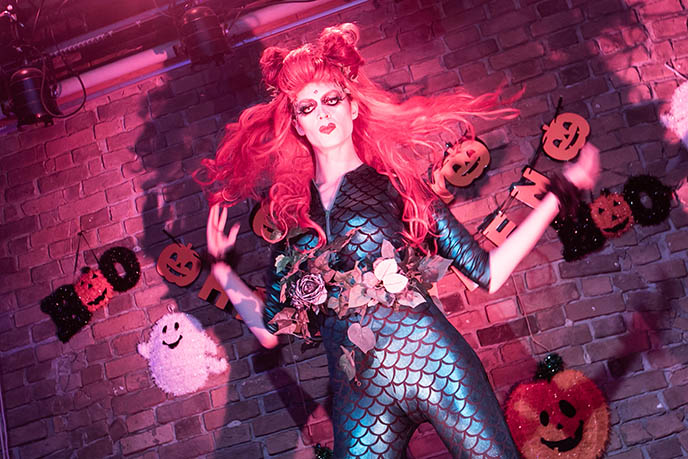
Before I turn over the wheel, I wanted to share some of Yukiro’s recent drag photos and projects (as Die Schwarze Frau). She and her Haus of Schwarz did a live, socially-distanced performance for Tokyo Closet Ball. Watch it here; our dead diva comes alive near the end.
For more fabulosity, check out Yukiro’s Witch Review series on YouTube — it breaks down the best horror B-movies, without spoilers!

And you’re invited to Yukiro’s online Halloween party on October 10, 8pm Japan time! Tune into the event here — Casket of Horrors. All members of her drag Haus will perform live, followed by a battle to the death between 10 spooky video contestants.
If this Evil Queen’s genius makes you bow down in awe, show your support by buying Yukiro a glass of red wine here.
(Above photos by: Akane Kiyohara from Beauty Blenda, by Haus of Gaishoku.)
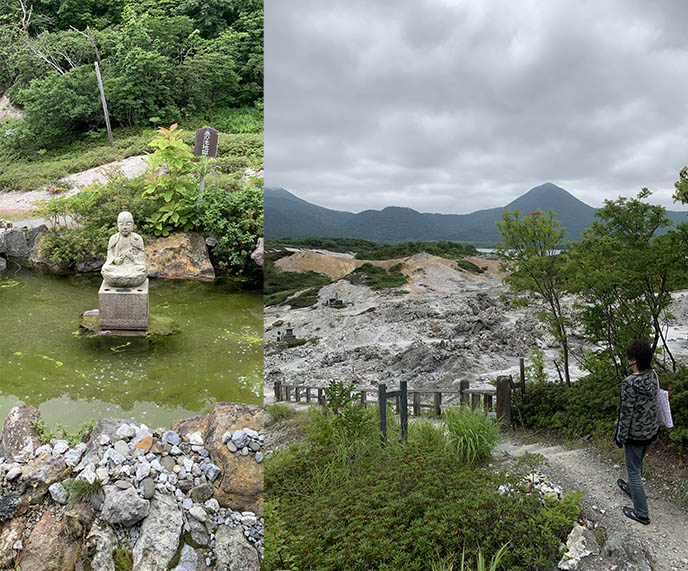
Now gather round children, and let’s listen to Yukiro’s Aomori travel story…
In July, my boyfriend and I escaped the Tokyo heatwave by taking a local trip to Aomori. It was our first time visiting the northernmost region of Japanʼs main island Honshu (本州), right below Hokkaido. We researched where to go and what to see – as well as the government’s safety recommendations, as our priority was to minimize the risk of getting or spreading COVID-19.
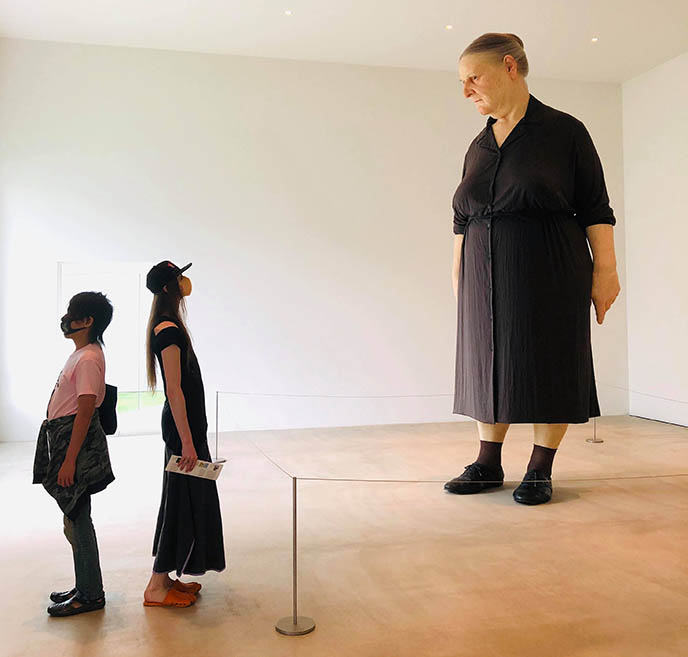
Our shinkansen route: We took the bullet train to Hachinohe (八戸) from Tokyo Station. Then, we took a local train to Misawa (三沢) where we booked our hotel. The trip took about 4 hours and cost about 18000 yen one way. We travelled just before the Japanese summer vacation so we avoided crowds, and got a very reasonable deal on our hotel, Hoshino Resort Aomoriya (less than 5000 yen per person a night!)

Pro tip: Pack a mask and hand sanitizer, and avoid crowded trains and rush hours. Our trains were more or less empty, and we saw almost no humans during this trip. Just what we desired!
Misawa is a rejuvenating spot, and we were delighted by the brisk air, surrounding nature, and no humans as far as the eye could see. Between Misawa station and the hotel, there was a 10-15 min walking path through small waterfalls and meadows.

Our hotel, Hoshino Aomoriya, was one of the best I’ve been to in Japan. We had an airy room and relaxation area. It bordered a Japanese park filled with art, birds, pony rides, jogging routes, and a pond with lotus flowers and auspicious carp fish.
The hotel also had two natural onsen (hot springs) free of charge for hotel guests, with both inside and outside options. The outdoor onsen was especially spirited as it was surrounded by trees, a pond, and trailing pink flowers.

The hotel displayed art from Okamoto Taro (岡本太郎); I loved his kappa-like spirit depiction. I was impressed by the collection of nebuta, or gigantic paper figures in the form of dragons, gods or Shoguns. Some were 9 meters in length, and spat out smoke and lights. Aomori has a yearly Nebuta festival (ねぶた祭) every summer, but it was cancelled due to the virus. In the future, I hope I can see this procession of musicians, dancers, and locals carrying the giant white floats.
I carried my mosquito repellent and sun lotion and hand sanitizer in my bag, as well as sunglasses and a mask of course. I was expecting mosquitoes but to my delight I wasnʼt bitten once in Aomori! In Tokyo I get bitten 1-3 times a day if I donʼt wear full cover up or spray myself heavily with repellent.

We chose to stay in Misawa because it was close to the memorial museum of Terayama Shuji (寺山修司). He’s an avant-garde poet, dramatist, writer, and film director — one of the most influential Japanese artists. Iʼm a big fan of his provocative movies and was eager to learn more about this extraordinary man.
Getting to the Terayama Shuuji museum: We took a 20 minute taxi ride from Misawa station, since there are only connecting buses on weekends and during vacations. All museums (and most stores) are also closed on Mondays in the Misawa area, and you more or less need a car to efficiently get around Aomori.
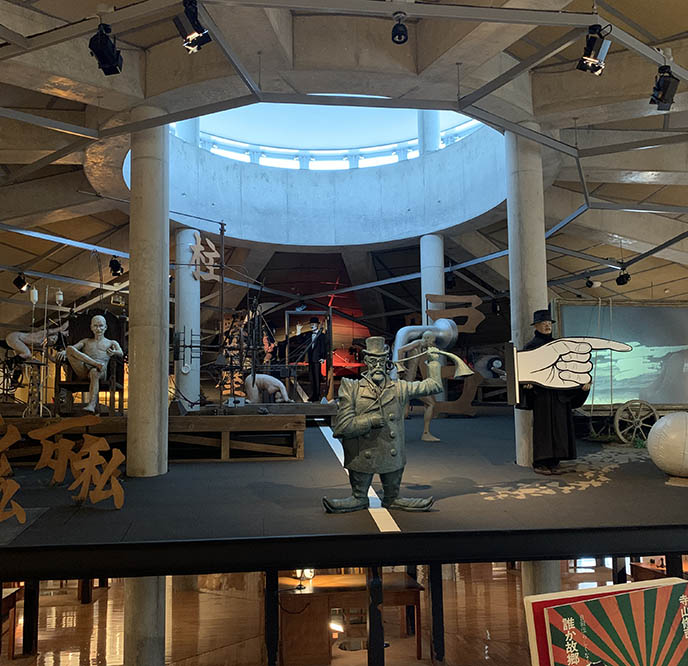
Needless to say the Terayama Shuji museum was very much worth the costly taxi ride (4000 yen one way). Every guest has to get their temperatures checked, and wear plastic gloves provided by the museum, as well as pay a small admission fee of 400 yen.

Terayama Shuji’s museum was as kooky and wicked as one would expect. The first room was a traditional exhibition space about his career, along with books, merchandise and collaboration pieces.
The second was very impressive since it was designed like a treasure hunt! There were 12 desks, and you had to use a flashlight, open drawers and find secret hidden panels. Each bench contained keywords to help solve the riddles. Inside the desk drawers were more facts, poems and interesting curiosa regarding Terayama; some even projected movie clips. The other parts of the room contained a library, and a ceiling constellation of his bizarre characters being lit up one after another. We bought some goods and left, without seeing another single visitor, and were very pleased.

We then took the local train to Aomori city, and from the station, we rode a bus to Heiwa Park (the Park of Peace – 平和公園) , which is said to be haunted! Unfortunately we did not encounter any ghastly beings, as it was empty as everywhere.
Then, we paid 400 yen to visit the memorial museum of Shikō Munakata (棟方 志功), a woodblock printmaker who reached international fame. Munakata was known for his eccentric personality and obsession with Vincent van Gogh; at a young age he claimed to be the “Van Gogh of Aomori.” The grandest piece in the museum was his “Ten Great Disciples of the Buddha” (二菩薩釈迦十大弟子) (1939), considered to be his crowning achievement.
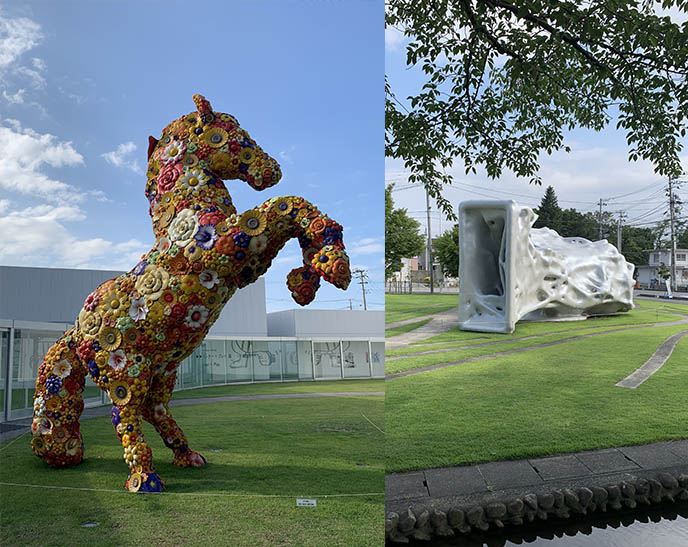
The following day we had the pleasure of meeting a local friend, Yoko, who kindly took time to rent a car and take us to must-see places. We realized how difficult it is to travel around Aomori without a car, so her help really made our trip worth writing about!
Our first stop was the Towada Art Center (十和田現代美術館). Outside, there was free street art for anyone to enjoy.

The infamous Yayoi Kusama (草間彌生) had an art platform opposite the main building, featuring her recognizable dotted sculptures. We also saw firefighters climbing a wall that was surprisingly part of the exhibit, and a friendly ghost manifestation.
PS: see La Carmina’s review of the Stockholm Yayoi Kusama exhibit here, as well as her trip to Naoshima Island (land of the giant pumpkins).
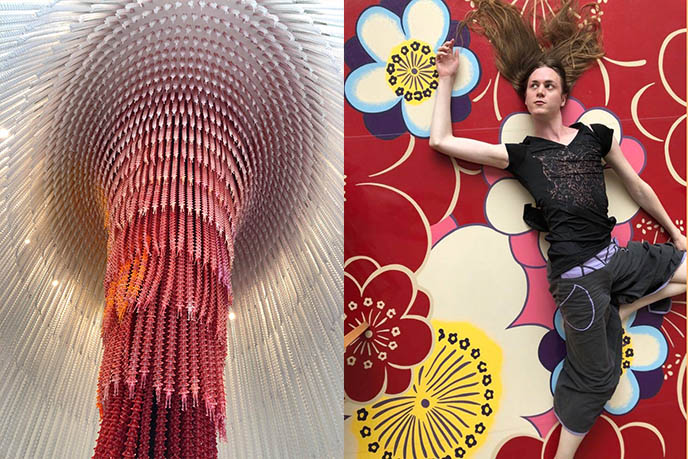
Also exciting was the Wish Tree, planted by Yoko Ono; you wrote your wish on a paper strip and hung it on one of the branches.
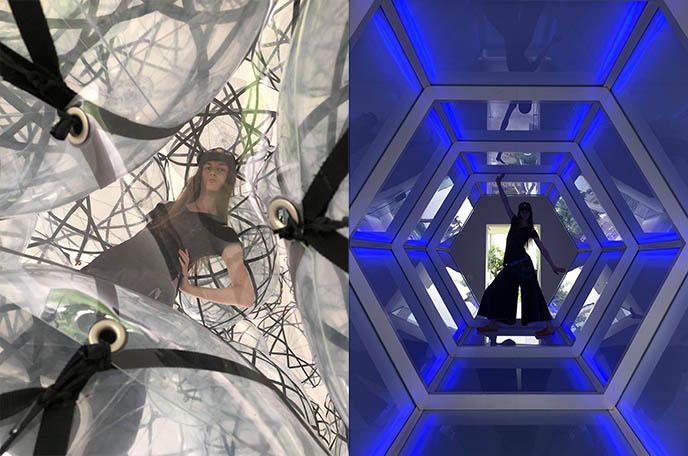
I enjoyed Towada’s many interactive pieces, and slightly hidden art that you had to search for. We took fantastic photos amidst the glass walls, and enjoyed installations from artists around the globe.

Next, Yoko took us to the Oirase Gorge (奥入瀬渓流) – a long path for hikers, through jaw-dropping waterfalls and picturesque trees. The gorge stretches 14 km from Nenokuchi (子ノ口) on Lake Towada (十和田湖) to Yakiyama (焼山). The strong current leads through a ferocious path with many rocks.
When we went, there was mud because of rain, and the thicket of trees made the temperatures quite cool. Even in the peak of the summer, I recommend wearing rubber boots and an extra coat layer.

After a few scenic stops, we made it to the peaceful Lake Towada, the largest caldera lake on Honshu Island. On one of the rocks in the water we could spot a tiny shrine, which belongs to a god who protects the lake. Yoko took us to Towada Shrine (十和田神社), and we admired the mossy stones that are said to have healing powers.

We also saw the “Statue of Virgins” (おとめ像) on the beach side of the lake. It’s the last remaining work of poet and sculptor Takamura Kōtarō (高村光太郎), and in our eyes, looked more like a romance between two women. Thanks to Yoko, we had a lovely day of nature and art.
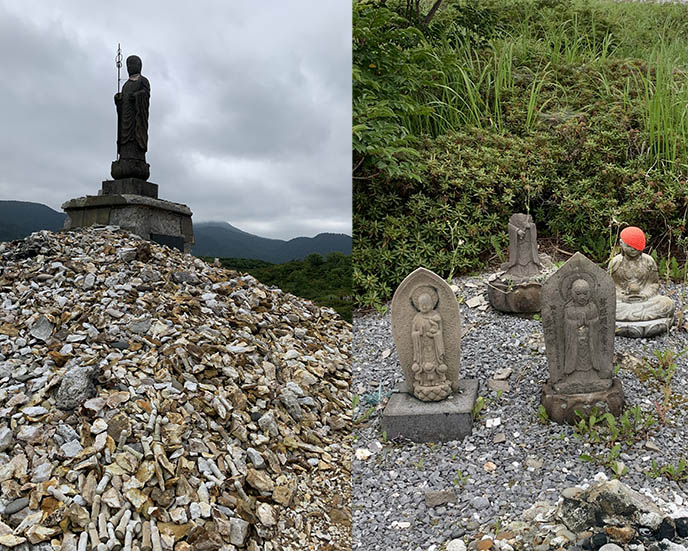
The next day we went to Mt. Osore, the Mountain of Dread: one of the three most sacred places in Japan. It is also a main shooting location for Terayama Shuuji’s movie “Pastoral: to die in the country” (田園に死 す).
Mount Osore is home to psychic mediums called “itako” who are traditionally blind, and undergo rigorous spiritual training. Itakos can summon the soul of a dead person; they become possessed, and speak to the customer in their spirit’s voice!
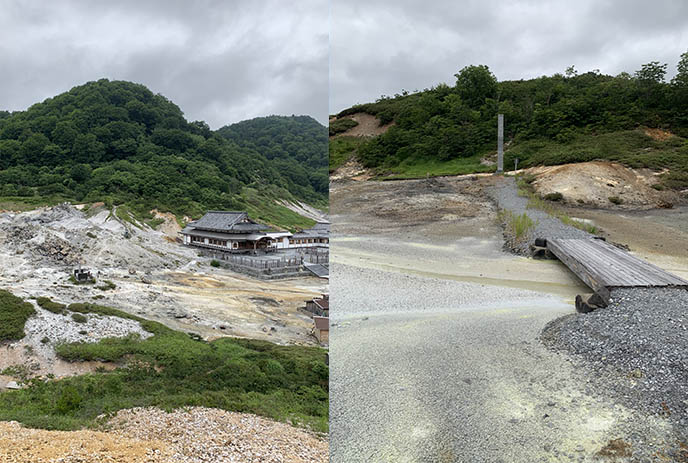
How to get to Mt Osore: From Misawa, take the express train direct to Shimokita Staton (下北), or take the local and transfer at Noheji station. (Not to be confused with Shimokitazawa, the hipster area in Tokyo frequently shortened to Shimokita!) Then, ride one of the three daily 40 minute buses to Osore. The trip took about 2-3 hours and cost 1900 yen for the train and 800 yen for the bus ride, per person each way.

Arriving at Mount Osore was like entering another realm. The holy ground is said to have spirits of the dead roaming about. It is also an active volcano, and is believed in Japanese mythology to be one of the gates to the underworld.

Admission info: The entry fee for adults is 500 yen, and there’s an overnight option with meals included for 12000 yen. The festivals with Itako spirit readings take place between July 20-24, and the area is open 6:00-18:00 each day between 1st of May to 31st of Oct (imagine going there on Halloween.) Osore is too cold in the winter for humans to visit… but not for spirits!

The place is gigantic, so allow several hours to walk around. The main temple, Bodaiji (菩提寺), is said to be founded 1200 years ago by the monk Enʼnin (円仁), and belongs to the Sōtō division of Zen Buddhism. The sanctimonious Mount Osore contains the highly acidic waters of the caldera lake. Lake Usori is in the center, surrounded by 8 mountain peaks representing the lotus flower’s 8 petals.
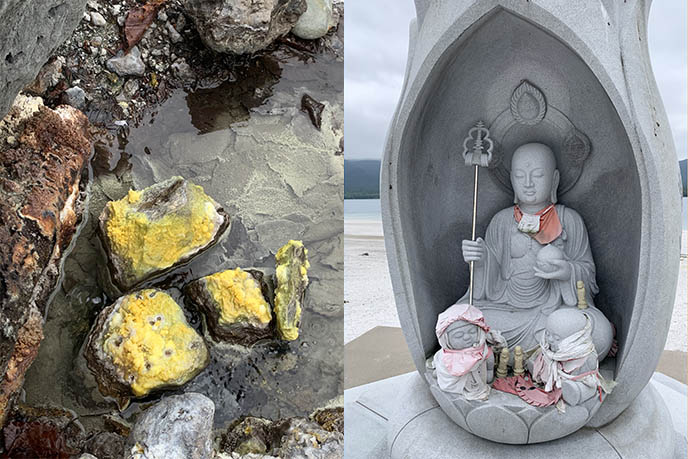
The area has many fumaroles (openings of the planet’s crust) emitting steam and volcanic gases (especially sulfur dioxide… the smell was everywhere). There are exactly 108 fumaroles, representing the 108 worldly desires and the 108 hells bound to them. Some of these hells even had their own signs with dramatic names, such as: The hell of salt, The eternal hell, The hell of severe crimes, and the hell of the blood-pounding pond!
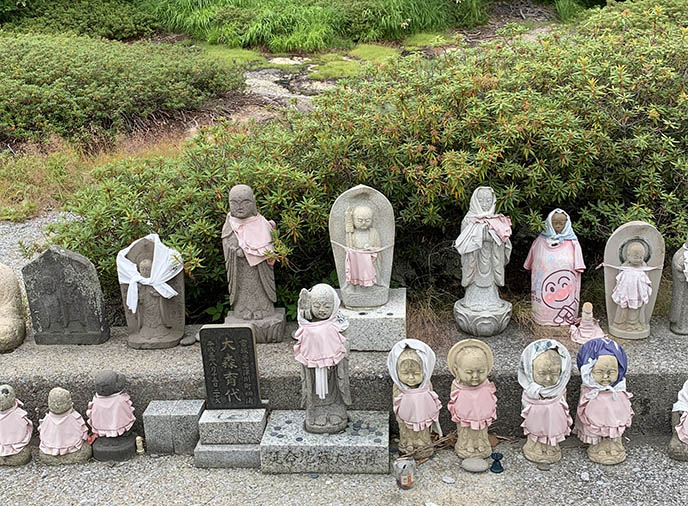
Mount Osore looked like a demon landscape. The paths bubbled with sulphuric yellow, orange or blue, while the white sand and grey stones made the scenery look like an endless graveyard. Adding to the melancholy were hundreds of Jizou bodhisattva (地蔵菩薩), or stone figures that guard over children who have died. Many of these small stone monks were clothed in handmade baby bibs and hats.

We saw pyres and monuments to famous monks, as well as offerings of cute pink windmill toys (風車). This famous Japanese toy represents unborn children, and is said to help them find peace in the afterlife. Seeing so many was heartbreaking and overwhelming.
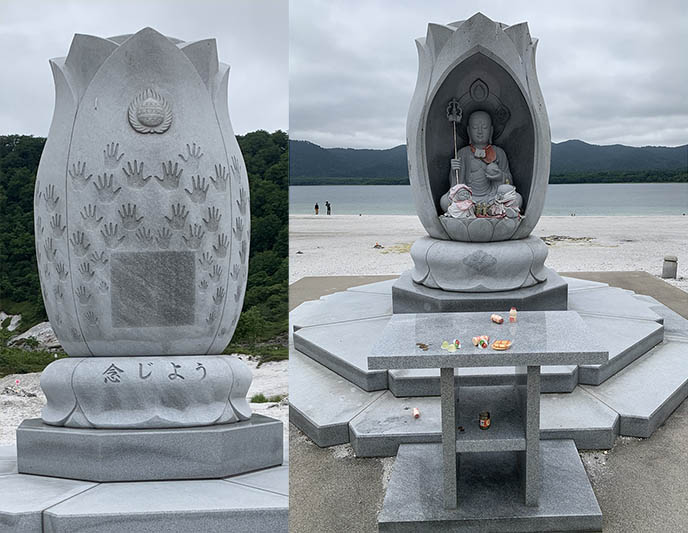
Osore had other meaningful tributes to those who have passed. I saw a large urn, shaped like a giant lotus, with hand-prints (mainly of children) on the back side. This was a monument for the unfortunate souls who died in Japan’s 2011 tsunami and earthquake.
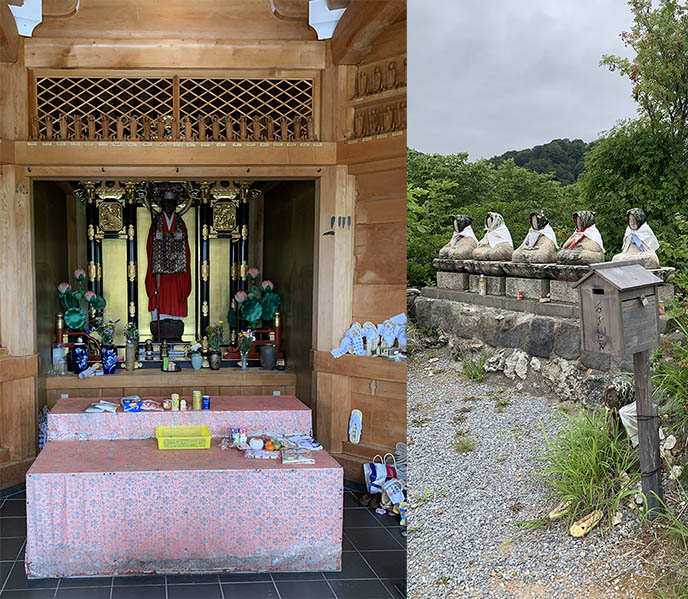
In one hut, I found heirlooms and old clothes belonging to the dead, with names of the unborn written on wood stripes all over the ceiling.
In Japanese media, the Mountain of Dread tends to be portrayed as a haunted place. It is said that you are cursed if you take any stones from the holy ground. In fact, this is a site of meaningful stillness and remembrance, which really spoke to me. While I loved the otherworldly Gothic atmosphere, I also felt this was one of the most serene places I’ve ever visited. There was no malice in the air – just a solemn peacefulness.

On the last day of our journey, we took a local train from Hachinohe to Shark Town station (伸), where there were an obnoxiously high number of seagulls by a shrine. These were actually “Black-tailed gulls” (Umineko 海猫). Fun fact: the word in Japanese Umi-neko is a compound of Umi – ocean and Neko – cat, so basically they are called “sea cats” or “cats of the ocean.”

We walked 10 minutes from Shark Station to Kabushima Shrine (蕪島神社) and as we got closer, we started hearing cat-like cries. It turned into a screeching as we approached the small harbour. Unlike regular seagulls, these beasts had black tails, a red ring around their eyes, a black mark on the beaks, and a sharp red tip: as if they’d just dug into raw flesh and still had blood dripping from their Gothic faces.
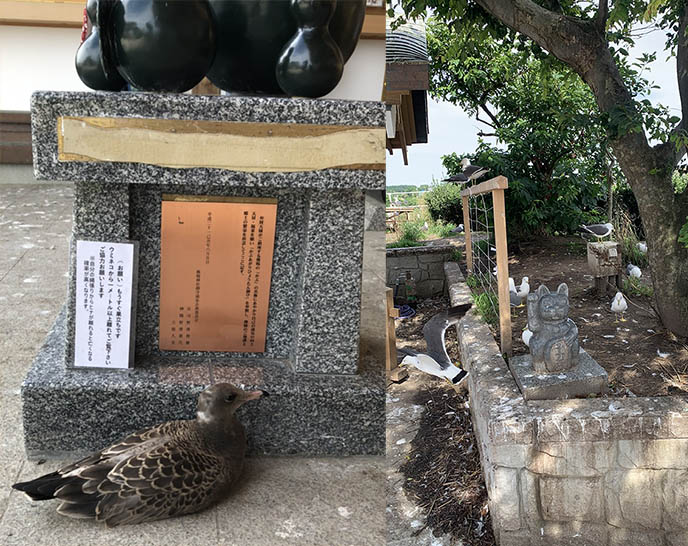
The little shrine on the hill burnt down in 2015 but was rebuilt as of last year. The workers stopped construction while the gulls were hatching their babies, so they could raise them in peace. In mid July, the hatchlings still wore a brown coat of feathers but were as large as adults. I was stunned by how they were unafraid of humans; you basically had to be careful not to step on them.

As you can imagine there was bird poop absolutely everywhere and we were afraid of being targeted from above! I would recommend this shrine if you are a fan of animals and birds in particular, but only if you have some extra time in Aomori. On the contrary, if you have a phobia or were freaked out by Alfred Hitchcockʼs “The Birds” I would suggest never to step your foot at Kabushima shrine!

Thanks to Yukiro for the eye-opening guide to Aomori! I didn’t realize there was so much avantgarde art and spiritual / Gothic scenery in this region of Japan. (Here are a few final pics from Towada Art Center.) Hopefully I can visit soon.

For more from Yukiro, watch his latest (freak)show drag performance here. The entire Haus of Schwarz (Stefani ST Sl;t , Le Horla, and Angel Heart) performed, with mommy dearest Die Schwarze Frau near the end! Le Horla’s spooky makeup was put on by Haus’ Drag Dad, Weryk.
If want something unproductive to do during quarantine, watch Yukiro’s YouTube series, Witch Review. Die Schwarze Frau dishes on her favorite old school horror cult B movies, sharing her darkest thoughts with you! There are no spoilers, so you can watch these reviews in (ill)-faith.
And if you’re inspired to dress in Gothic or Punk clothing, check out Punk Rave Store — they have many dark styles for men and women.

And we order you to tune in to Yukiro’s Halloween livestream extravaganza, called Casket of Horrors! All members of Haus der Schwärze will perform live, and then there will be 10 spooky videos submitted from around the globe. The winner will be crowned “The Queen (or Queer) of Halloween 2020!” Watch the live-stream online (here’s the info) on 2020/10/10 at 20:00 Japan time, if you dare.
Love it to death? Then support Yukiro by buying him a glass of red wine here!

SHARE & COMMENT
I’m giving a TED talk! TEDxSFU Vancouver conference speaker. Offbeat travels in Prague, Michelin star restaurants.
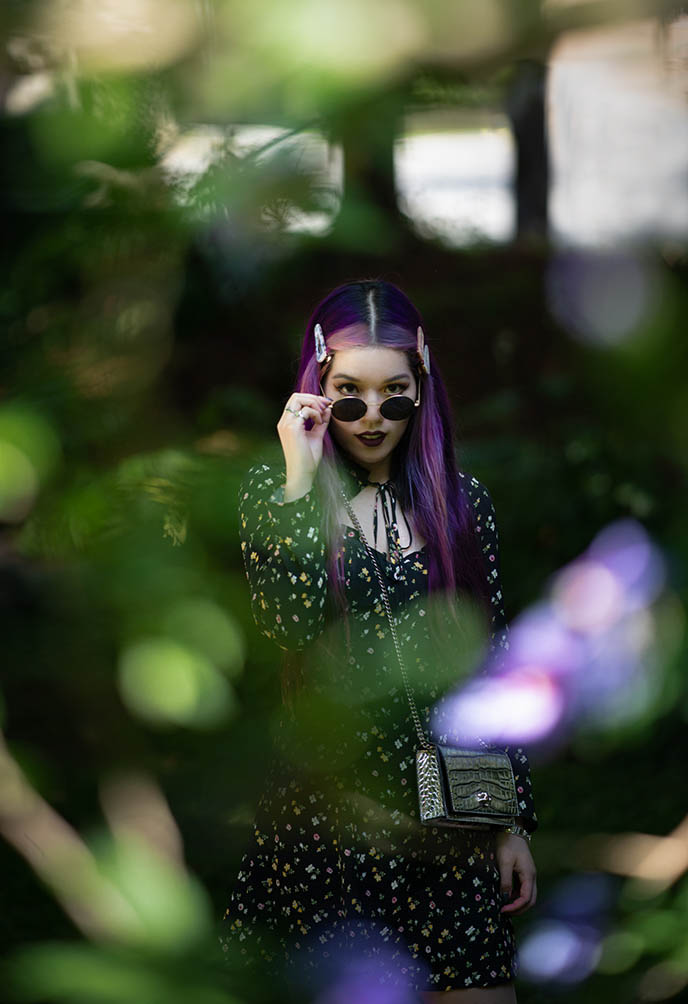
2020 has been topsy-turvy, to say the least…
But on my birthday (Aug 17), I’m pleased to share some happy news. I’m honored to have been selected to give a TEDx talk in Vancouver!
(Portraits by Kristin Thorogood Photography, assisted by Andre Dupuis.)
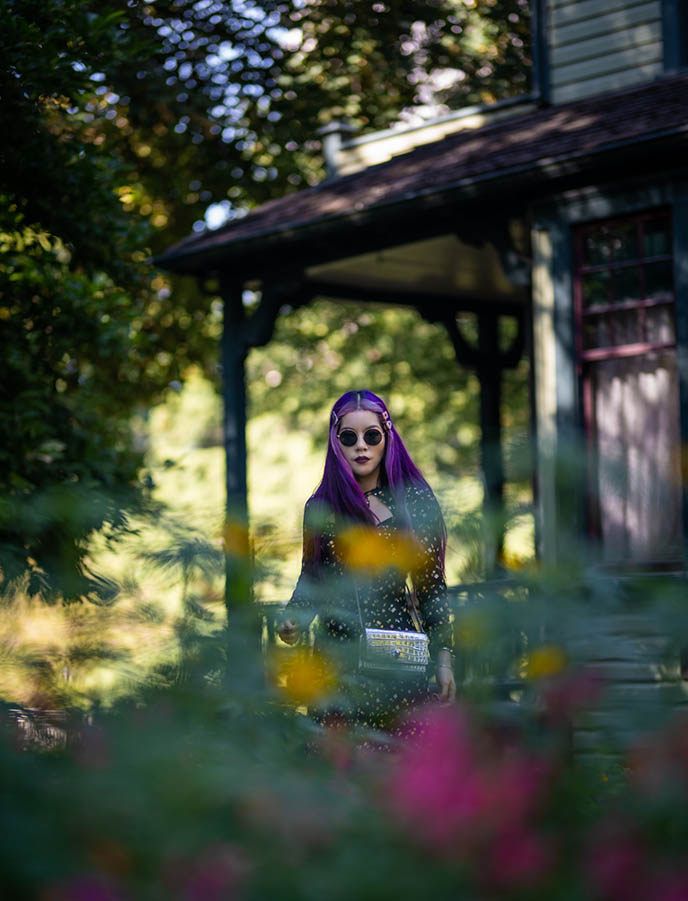
This fall, I will be the first person ever to give a TED talk about Goths! My TED talk will break apart six Goth stereotypes, and share my personal journey into the subculture. I’ll tie this to the larger theme of unraveling prejudices, and how we should be more compassionate towards those we consider different from us.
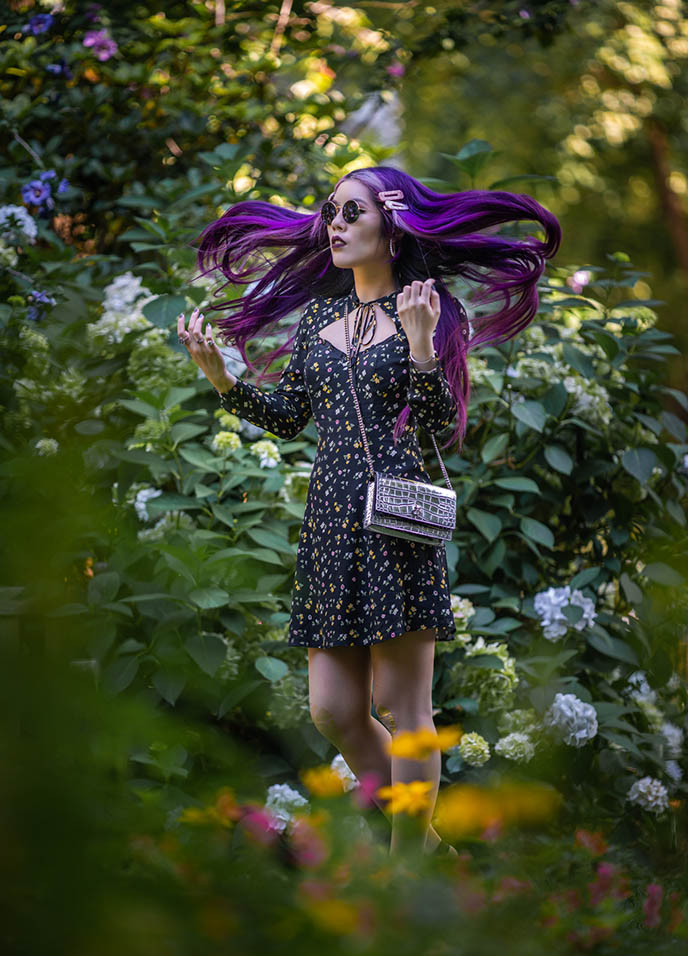
2020 is the 10th anniversary of the TEDxSFU conference, and this was the most competitive year yet for applicants. (I went through a comprehensive application and two rounds of Zoom interviews, before receiving the good news.) Now, my fellow speakers and I will be spending the next months honing our speeches, and running through rehearsals.
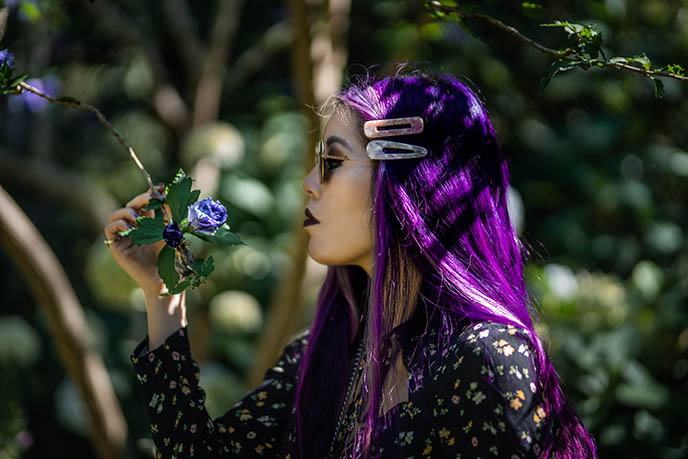
This year’s TED Vancouver will be safely pre-recorded because of COVID, and live-streamed on November 14 or 15. (I’ll have more details for you soon, so you can watch it online). My talk will also be featured on the official TED.com website.
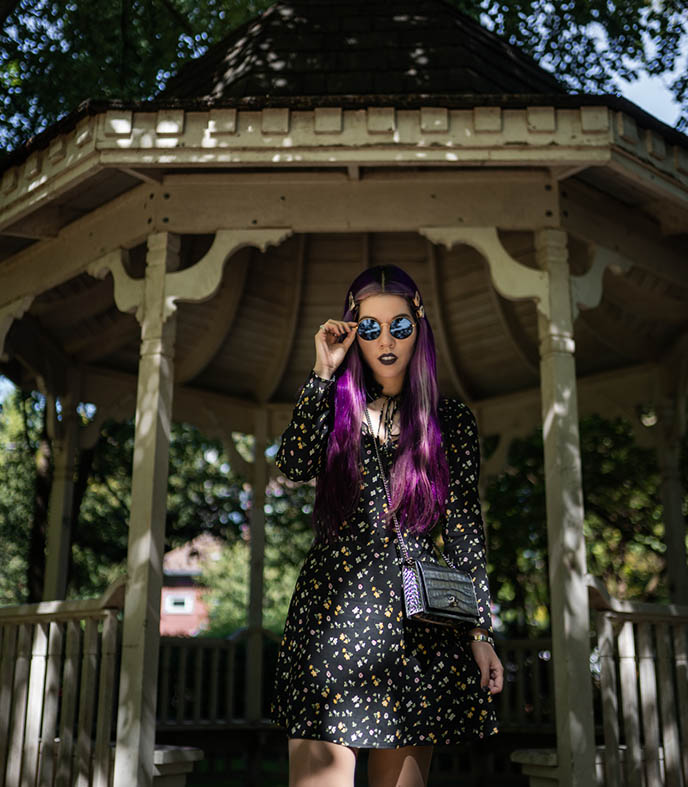
In a year of cancelled projects, I’m grateful I can be part of TED, and dive into something new and meaningful. It’s been a pleasure getting to know the TEDx SFU team and other remarkable speakers. I hope you’ll tune in to the TED x 2020 Vancouver event in November, and get inspired by our “ideas worth spreading.”
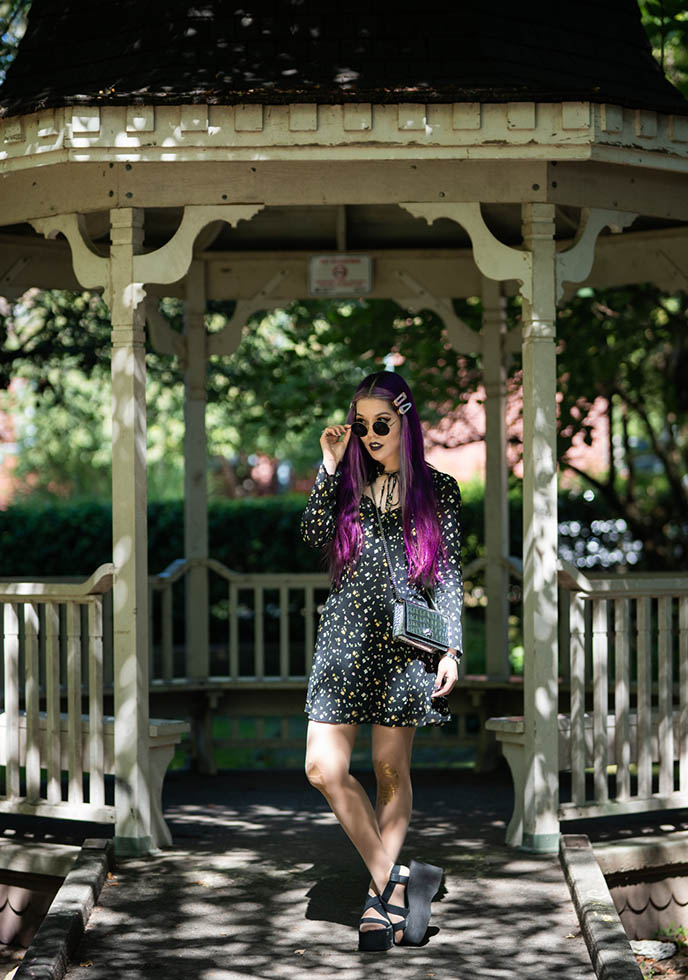
Outfit details: This summer dress is a gift from my aunt in Hong Kong, similar to the Reformation Vivianne mini dress. Love the Queen Anne cut-out neckline with a ribbon tie, and Georgette floral print. (Check out Reformation’s Victorian dress here.)
My silver skull crossbody bag is by Alexander McQueen, the king of Goth couture.
Shop my style by clicking below:

These dreamy portraits are by Kristin Thorogood Photography, assisted by Andre Dupuis. I think you can tell that we had fun with this photoshoot! (Love how Kristin captured my hair flip in motion, with her Sony mirrorless DSLR.)
It was a joy to catch up with my friends while they were in Vancouver. Kristin has been to 70 countries, and specializes in documentary-style travel photography and portraits. Andre is a director and cinematographer (you may know of his work from the Canadian TV show Departures, which I think is one of the best travel shows ever made). Both are passionate travelers, and I hope we can do more together soon.

Kristin shot these photos outside Roedde House, a Victorian manor in Vancouver’s West End that is now a historic museum. It was built in the late 19th century, and designed in the Queen Anne Revival style (possibly by famed architect Francis Rattenbury.)
The architecture happened to match the Queen Anne neckline of my dress! (Find Reformation’s Vivianne dress here, which has the same high neck with cut-out keyhole, and flower pattern.) My crocodile skull evening purse is Alexander McQueen,

Love how Kristin created a “secret garden” feeling by shooting through the purple flowers.
Enjoy more of Kristin Thorogood’s worldwide photography on her Facebook page and Instagram. She’s currently traveling through Canada with Andre, and capturing unexpected sights — such as the grasslands and sand dunes of Saskatchewan.

An enormous thank you to TEDxSFU for having me be part of this year’s conference! You can see updates about the TED 2020 Vancouver event on their Instagram and Facebook.

The team asked what storytelling meant to me. I replied, “Sharing my lived experience with honesty, as well as amplifying voices that tend to be overlooked. In my writing and travel TV shows, I try to shine a positive light on alternative subcultures, such as Goth — in the hope that this can open people’s minds to different ways of being.”

Speaking of storytelling, and 2020 pivots — I’ve been doing more freelance writing as of late. It’s been nice to stretch my writing muscles for new publications. (Plus, I can’t do my usual travel and television work.)
I’m delighted to share a personal narrative about my hair & self-identity, published by Yahoo Canada Style! I wrote about getting my hair done after months in lockdown (with dramatic before-after transformation photos). I also featured my friend Molly’s traumatic cancer head-shave, and my stylist Chad’s wise words on the transformative power of hair.
Intrigued? Then check out my beauty essay here on Yahoo.
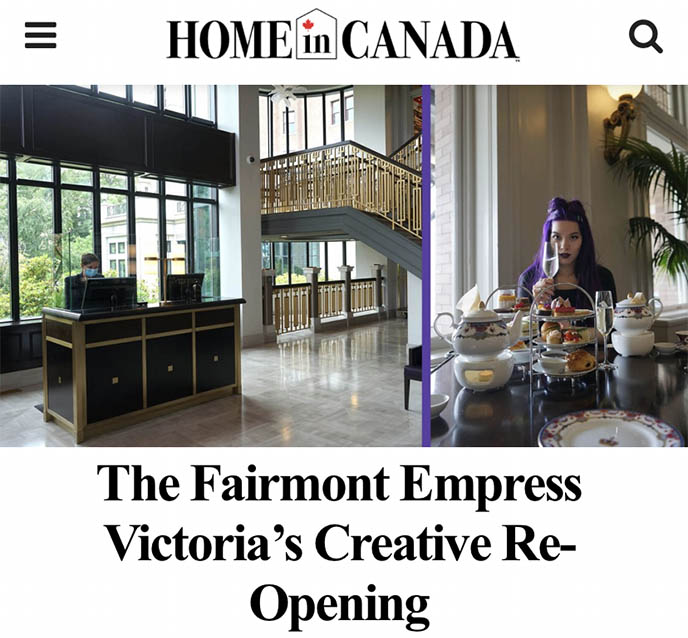
I’m also writing regularly for national print magazine, Home in Canada, and loving it.
Here’s my latest travel article about staying at a hotel during the pandemic. (You can see more from my Fairmont Victoria stay in this blog review as well.)

And now, a birthday treat for you… A Prague travel diary from Joey Wong, one of my most constant travel companions! Since he’s UK-based, he was recently able to do a safe trip to the Land of Absinthe.
Even if I can’t fly anywhere for months to come, I can bring you new travel stories from my friends around the world. Let’s begin with Joey’s favorite Prague hipster spots such as an art factory, and Michelin-starred restaurants.

Ahoj! My name is Joey, trusted traveller and photographer friend of La Carmina. Together we’ve traveled and photographed the far corners of the globe from Easter Island to Japan.
Like many of you, travelling has become an integral part of my life so when COVID-19 hit, my lifestyle and priorities were flipped upside down. However, if there’s one thing this pandemic has taught me, it’s to do what you can when you can. So with super-hygiene and social distancing becoming our new normal, I knew it was time to take advantage of the low COVID case numbers in Europe and start travelling again. My destination of choice? Prague!
Without further ado, join me during my week as a digital nomad and experience the unexpected perks of traveling during a pandemic, including tourist-free sites, private dining experiences, and the same incredible experiences we gain when exploring a different city and culture.

I first visited Prague in winter 2016, and it easily became one of the most majestic, photogenic cities I had ever been to. While I typically lean towards off-the-beaten path travel, I couldn’t stop photographing Prague’s magnificent sites including the Medieval statue-lined Charles Bridge, and interiors of the St. Vitus Cathedral (above).

During my stay, a light layer of snow dusted the city, making my experience more magical.
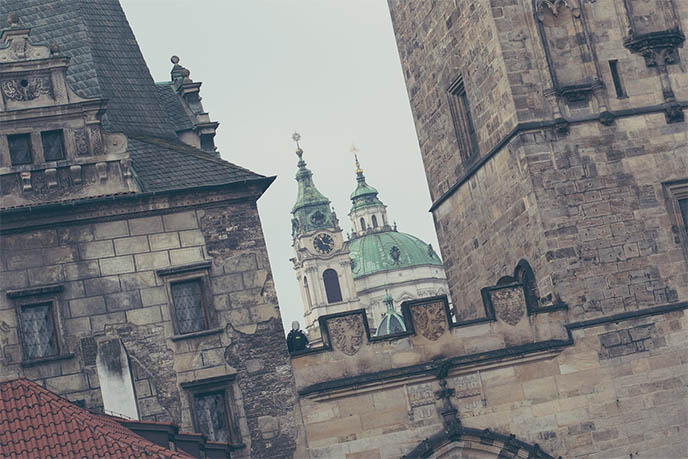
When my office in London closed due to COVID-19, I discovered an unexpected but welcomed consequence: the ability to work from anywhere. In July, case numbers were down, so I booked a flight to Prague. After months in lockdown, I was excited to spend a week both working and exploring.
In 2016, I ticked off Prague’s most-visited tourist sites. This time, I wanted to make sure my experience in the Czech Republic was different from my first. I was keen to base myself in a comfortable, convenient, non-touristy neighborhood where I could pop out to get anything I needed in a pinch, yet still be in walking distance to major sights and restaurants.

Secret. Hip. Bohemian. These are the words you’ll hear people say when describing Karlin, the neighborhood where I chose to stay. Located close to the northeast of historical Old Town, Karlin was not just trendy. It was also extremely convenient and surprisingly affordable. The cost of my private Airbnb apartment per night was cheaper than my average per night rent in my shared London flat!
What I love about neighborhoods like Karlin is the contrast of new and old. I was endlessly discovering new things to photograph – one being the Church of Saints Cyril and Methodius, which has been standing since 1863.

After a dinner out, I stumbled on the Karlin Barracks which is – you guessed it – the site of former military barracks. Now it is a huge, multi-building cultural complex that contains a bar, gallery, music club, fire-pit, and even beach volleyball! On my visit, a full-on summer cinema was underway.

Random discoveries like the Karlin Barracks are what makes me love to travel so much, so it should be no surprise that one of my favourite things to do in any city is to just roam. Due to time zones differences (GMT +2 means I didn’t have to start work until 10AM) and long summer evenings, I had the privilege of having plenty of exploring time before and after work.
I had expected Prague to be a haven for street art, but surprisingly, it was not. But I was in for a pleasant surprise: the lack of street art was overcompensated by brilliant public sculptures by the acclaimed Prague-born artist David Černý. David Černý has several provocative pieces dotted across the city and I’d highly recommend a sculpture walk to spot them all.

You absolutely should not miss Černý’s latest installation The Head of Franz Kafka. This sculpture is made of 42 rotating metallic panels, all rotating individually to form the shape of the famous-Czech novelist. You’ll have to see it with your own eyes to believe it. After sending my brother a short video clip of the statue in action, he asked if it was CGI.
When you’re on your sculpture hunt, don’t forget to look up! I spotted Černý’s work high above on the Žižkov Television Tower. Can you see the babies crawling up the tower? If you don’t look up, you’ll also miss Man Hanging Out, a depiction of Sigmund Freud dangling from a pole attached to a building rooftop in Old Town.

Besides some amazing sculpture, Prague has a lot of don’t-miss galleries and culture centers — such as the DOX Centre for Contemporary Art and Vnitroblock.
If you want more of an alternative vibe, head to Meet Factory, a non-profit organisation and contemporary art factory founded by David Černý himself. While it’s a bit out of the way from the main sites and neighborhoods, you won’t be able to miss the MeetFactory complex – easily spotted with a large, red automobile hanging from the building facade. Inside, expect contemporary and alternative art from up and coming artists. One piece that stood out to me was a BDSM-themed pillow.
When you’re finished with your sculpture spotting and art hunting, it’s time to get a bite to eat. Prague, like many cities in continental Europe, has amazing Monday – Friday ‘business lunch’ deals. Three course meals can be had at the fraction of the dinner price.
Since I was working remotely and had limited free time, I carefully researched and reserved all the best Prague establishments. From Michelin starred modern Czech to Vietnamese street food to burgers and beyond, my highest recommendations are…

Divinis
Elegant yet unpretentious, Divinis was by far the best meal out of my entire trip. I wouldn’t expect Prague to have fantastic Italian, but it absolutely did. I was particularly impressed with the amuse-bouche, which was a creative play on a garlic dough ball. I went in at around 2:00PM and had the entire restaurant to myself – an unexpected, yet welcomed perk to the recent pandemic perhaps?

Cafe Imperial
I was committed to avoiding all tourist traps, so I went to Cafe Imperial with hesitation. However, it ended up being one of the most memorable dining experiences on my trip. I was quickly won over by the fantastic and extravagant Art Deco atmosphere and attentive staff. I opted for the aptly named Imperial Breakfast that included a poached egg over avocado tartar. I felt like a VIP throughout my entire experience.
Pho Vietnam Tuan & Lan
Pho in Prague? Really? I was just as surprised as you are, but Prague has a surprisingly large Vietnamese food scene — so expect to see several pho and bahn mi eateries across the city. If you need a quick Asian fix, head to Pho Vietnam Tuan & Lan. There’s more than one of these in the city, and I’d recommend the bistro venue at Slavíkova 1. Get takeaway and eat in the nearby leafy Jiřího z Poděbrad Square with the locals.

Kro Kitchen
After months in lockdown, I definitely indulged on my trip. So after my pho in the park, I walked to Kro Kitchen just 2 minutes away to have my second dinner. They are famous for their rotisserie chicken, but I ordered their signature lechon which was served over mashed potatoes, grilled pak choi, black garlic gray, and heaps of spring onion. Yum.
Pro tip: If you don’t stay in Karlin, stay in Vinohrady. This is the neighborhood where Pho Vietnam Tuan & Lan and Kro Kitchen are located. I often found myself coming back for the amazing eats, and it’s also the center of LGBTQ+ nightlife!

Eska
Part bakery, part cafe, part restaurant, and pure awesome, there’s nothing secret about Eska anymore. Located in Karlin and already awarded a Michelin Bib Gourmand, the airy ambience, innovative menu and hybrid-dining concept makes Eska a must-visit on your trip to Prague. You can even take home some of their famous pickles!

I’ll be honest – I booked my trip to Prague with hesitation but I’m so glad I went. For me, travelling has enabled me to live my life with open eyes and an open mind. Traveling is invigorating and it gives me a sense of purpose. If you feel restricted because of the current environment, do not lose hope – travel will return for all of us and when it does, it will be even more meaningful.
I can’t wait to reunite with La Carmina for more worldwide escapades where our ‘normal’ is searching for the not normal – the off-beat, alternative, off the beaten path adventures that we love to capture and share.
Until then, stay safe, stay hopeful, and look out for my next guest post with exclusive photos from Sedlec Ossuary: the church adorned with bones from over 40,000 human skeletons.
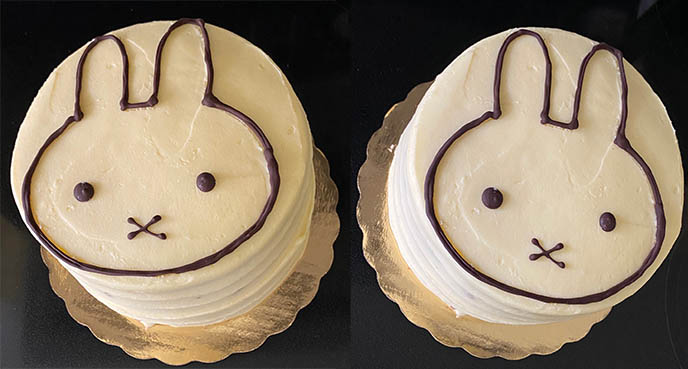
Dík (thank you) Joey for sharing his story. And thanks to all of you who left me birthday wishes! If only I could give everyone a slice of my Miffy cake. (I got this carrot cake, decorated with the face of my favorite cute bunny character, from Whole Foods).
Coming up… I have another guest travel post for you, from Yukiro in Japan!

Can’t wait to reveal more about my TEDx talk on Goth culture as well. Cheers to everyone who encouraged me to be part of TED.
Find my clothing below, including this Victorian high cut out neck dress and Alexander McQueen bag:

 LA CARMINA
LA CARMINA






